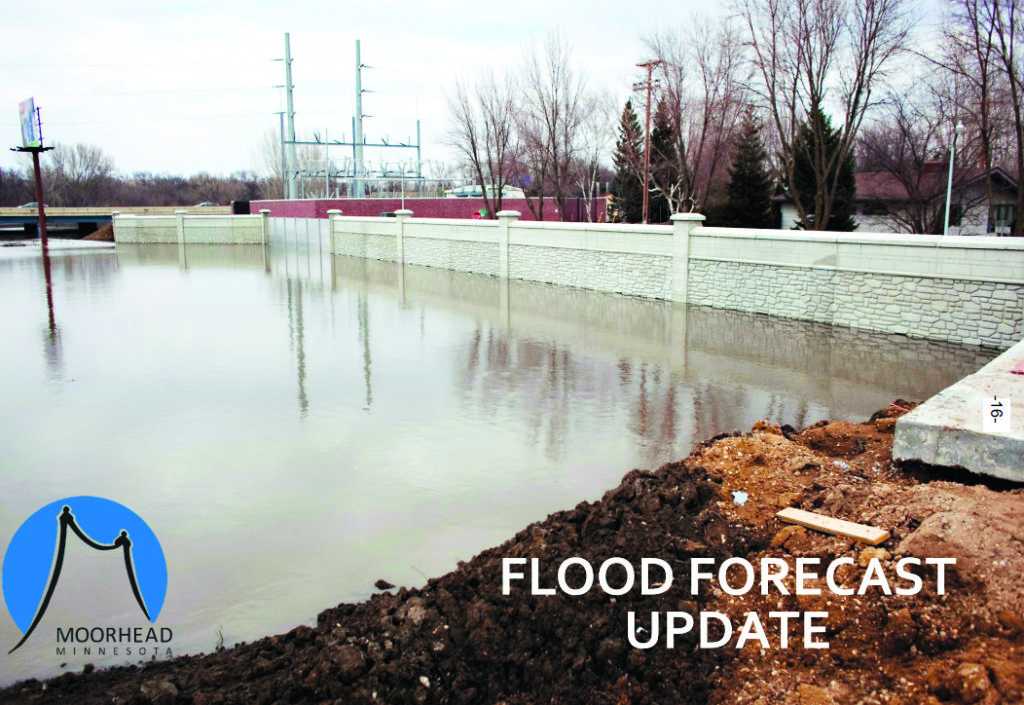
Nancy Edmonds Hanson
Spring weather is always a wild card. But city engineer Bob Zimmerman reported to the Moorhead City Council Monday that the prospects of successfully fighting this year’s flood are looking very good. If the Weather Service’s worst-case flood scenario of less than 39 feet is reached, he said, “We will need zero sandbags” for public infrastructure.
Only 59,500 bags would be called for to protect private property at the predicted maximum crest – an outcome given just 1-in-20 odds in the latest forecast.That includes the last homes along 40th Avenue North that are still waiting for permanent levees, which will be installed this summer. The city has access to 30,000 sandbags stored in a heated warehouse that were not needed in 2019’s flood fight.
“The Weather Service’s probabilistic crest forecast has moved down a foot and a half since their first came out at the end of January,” the engineer told the council. It has declined from their most pessimistic possibility (with odds of 5%) of a maximum crest of 40.6 feet issued Jan. 24 to the latest prediction, 39.1 feet, issued on Feb. 27. While less foreboding, that still would place it among the top 10 in local history.
The final probabilistic forecast is due March 12. Citizens will be updated on the city’s flood-fighting plan the same evening at 6 p.m. in a public meeting at the Hjemkomst Center.
A probabilistic forecast, Zimmerman explained, is determined before the Red River begins its flow, based on historic and computer models. It will soon be replaced by deterministic forecasts as the river opens up. At that point, forecasts of river stages will be posted and revised hourly. Active measures to protect city property and homes on the north side where buy-outs and easements are still being negotiated will begin after the deterministic predictions are available.
The Red River is considered at flood stage when it reaches 18 feet. Minor flooding begins at 25 feet, and major at 30 feet. “We’re virtually guaranteed major flooding,” Zimmerman said. Five of the seven factors contributing to the forecast already point in that direction: Higher than average fall moisture and river base level; frost depth (“quite shallow, but with saturated soil,” he said); a greater than normal winter snow pack; and high water content in the snow. Two important unknowns remain as the river begins its rise – the spring thaw cycle and the possibility of heavy spring rains. “So far, the weather has been ideal,” he noted.
Years of flood mitigation efforts, including $110 million in infrastructure upgrades, levees and gates, have been designed to protect the city to a flood crest of 41 feet, plus several feet more of free-board to deal with impacts from ice jams, heavy rains and other unpredictable events.
The council ratified Mayor Johnathan Judd’s emergency declaration made earlier Monday. The declaration activates Moorhead’s detailed emergency operations plan and makes the city eligible for state and federal reimbursement of flood-related costs.
One innovation this year, Zimmerman said, is the designation of four “zone liaisons” to help businesses and homeowners potentially affected by flooding. They include Clay Lexen, 28th to 70th Avenues North; Andrea Crabtree Nayes, 28th North to Center Avenues; Mike Aamodt, Center Avenue to Interstate 94; and Levi Hockett, I-94 to 70th Avenue South. Contact information is available on the flood pages of the city’s website, www.cityofmoorhead.com.
BUILD grant application
The council decided to try again to secure a federal grant for the 11th Street underpass project – their fifth attempt to be chosen for funding through the U.S. Department of Transportation.
Engineer Zimmerman reported that last year’s application had been rated in the top 20% by USDOT staff and deemed “highly recommended,” but didn’t make it to the final award. Six hundred sixty-six applicants had applied for amounts in excess of 10 times the money available. After the program closed, local officials met with the federal team to learn more about how to strengthen their appeal. “We benefited greatly from that conversation,” he told the council.
The city’s 2020 application asks for $25 million, the maximum allowed in the $1 billion competition. It would amount to 30 to 40% of total project cost.
The council approved spending a total of $28,625 to prepare the application and hire a federal relations firm to help shepherd it through the decision process. Of that amount, the city’s share of the application preparation cost is $3,625, or one quarter of the $14,500 cost. “The Minnesota DOT is picking up the rest of it,” Zimmerman said. “They’re very supportive of the project. This is a gesture of partnership that shows how important it is.” A $3 million appropriation to support the project’s development is part of Gov. Tim Walz’s budget request.
Asked by council member Sara Watson Curry about the likelihood of success, city manager Chris Volckers responded, “Competing for this grant is worth every penny it will cost. MNDOT putting in extra funding toward the application shows that they agree. This project has a lot of potential, and they see it, too.”


